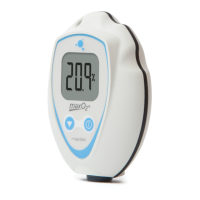4.0 FACTORS INFLUENCING ACCURATE READINGS
4.1 Elevation Changes
•Changesinelevationresultinareadingerrorofapproximately1%ofreading
per 250 feet.
•Ingeneral,calibrationoftheinstrumentshouldbeperformedwhenelevationat
which the product is being used changes by more than 500 feet.
4.2 Temperature Effects
The MAXO
2
®
+
willholdcalibrationandreadcorrectlywithin±3%wheninthermal
equilibrium within the operating temperature range. The device must be thermally
stable when calibrated and allowed to thermally stabilize after experiencing
temperature changes before readings are accurate. For these reasons, the
following is recommended:
•Forbestresults,performthecalibrationprocedureatatemperaturecloseto
the temperature where analysis will occur.
•Allowadequatetimeforthesensortoequilibratetoanewambienttemperature.
CAUTION: “CAL Err St” may result from a sensor that has not reached thermal
equilibrium.
4.3 Pressure Effects
Readings from the MAXO
2
®
+
are proportional to the partial pressure of oxygen.
The partial pressure is equal to the concentration times the absolute pressure.
Thus, the readings are proportional to the concentration if the pressure is held
constant. Therefore, the following are recommended:
•CalibratetheMAXO
2
®
+
at the same pressure as the sample gas.
•Ifsamplegasesflowthroughtubing,usethesameapparatusandflowrates
when calibrating as when measuring.
•TheMAXO
2
®
+
oxygen sensor has been tested at pressures up to two
atmospheres absolute. Calibration or operation above this pressure is beyond
the intended use.
4.4 Humidity Effects
Humidity (non-condensing) has no effect on the performance of the MAXO
2
®
+
8
M A N U F A C T U R E D B Y M A X T E C , I N C .

